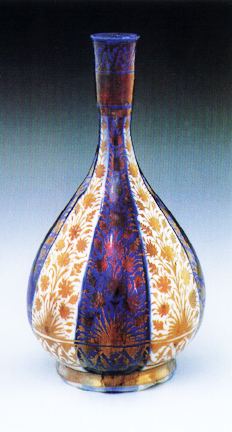
Vase, Earthenware with underglaze cobalt and overglaze luster
Safavid Dynasty, Kashan, Persia 1680 CE, 10.5" height
ART 198 - HISTORY OF WORLD CERAMICS
| This elegant vase, made in the late 1600's, clearly shows the influence of Ming dynasty porcelains that found their way into Iran along the silk route. The teardrop shape and the use of an underglaze cobalt blue on the white clay body echo Chinese prototypes, however the Persian potters did not know how to produce porcelain. They used a lower firing white earthenware to mimic the effect, but this clay does not have the vitreous, translucent quality of porcelain. What is clearly Islamic about this style of work is the surface ornamentation, with vigorously painted floral designs in overglaze luster shimmering across the surface. The luster design on this piece reminds us of the kind of decoration seen in manuscript illumination of the period. During this time, the city of Isfahan was the capital of the Safavid rulers, and this piece was made in the luster producing center of Kashan for patrons in Isfahan. At Isfahan, the ruler Shah Abbas I would beautify his capital with palaces, bridges, mosques, and marketplaces. He was an avid pottery collector, and his collection is still intact at his family shrine at Ardabil in Azerbaijan. | Vase, Earthenware with underglaze cobalt and overglaze luster Safavid Dynasty, Kashan, Persia 1680 CE, 10.5" height |
|
|